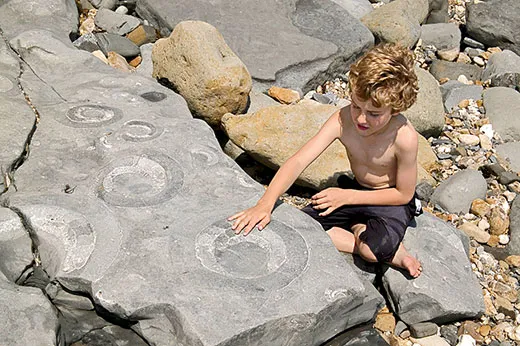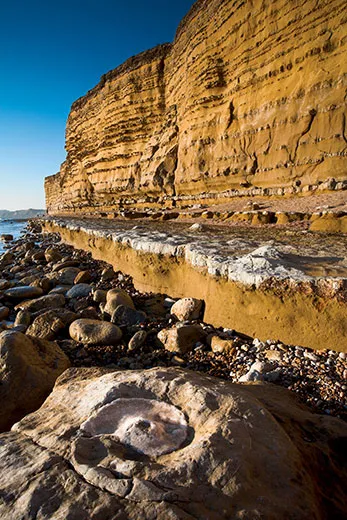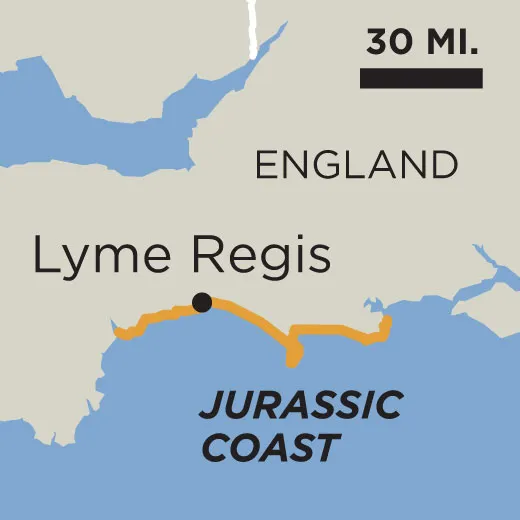Evolution World Tour: Jurassic Coast, England
The best opportunity to play paleontologist is on the southern coast of England, a site rich with marine reptile fossils
Just down the shore from where children build sand castles and parents relax beneath brightly colored umbrellas, fossil hunters chip away, hoping to uncover a piece of England’s prehistoric past. They come to this section of the southern coast not only in summer, but also in winter, when heavy rains beat against the cliffs, washing away clay and revealing bones dating back hundreds of millions of years.
“It’s incredibly easy to walk along the coast and find something no one has ever seen before,” says Paul Barrett, a vertebrate paleontologist at the Natural History Museum in London.
The Jurassic Coast, as this region is known, stretches for almost 100 miles and encompasses 185 million years of earth’s history. At the far west end, in Exmouth, the cliffs date to the Middle Triassic, some 240 million years ago. There, fossilized sand dunes and river channels conceal bones of early amphibians and land reptiles. On the eastern end, the Isle of Purbeck yields a jumbled mix of remnants from the Early Cretaceous period, 140 million years ago—everything from mollusks and crustaceans to dinosaurs and mammals.
The area in between is home to one of the most complete sequences of Jurassic rocks ever found, spanning nearly the entire period, 200 million to 145 million years ago. “It’s one of the richest places for looking at marine reptiles,” Barrett says. Over the centuries, the site has given scientists a peek into a lost undersea world populated by dolphin-like ichthyosaurs, long-necked plesiosaurs and coiled mollusks called ammonites. Important land dwellers were found here as well—notably an early armored dinosaur called Scelidosaurus, an ancestral relative of stegosaurs and ankylosaurs.
Many of the rocks along the Jurassic Coast are stacked in neat layers, which enabled scientists in the 18th and 19th centuries to map them and study the geologic processes that formed them. At that time, the prevalent belief was that God had created the earth a mere 6,000 years before and that the planet had remained essentially unchanged since the time of Noah and the great flood. But the rocks along these English shores added to the growing pile of geologic evidence that, in contrast to the biblical interpretations of the planet’s origin, the earth was hundreds of thousands, maybe millions, of years old. (Scientists later determined that our planet is, in fact, 4.6 billion years old.)
And the fossils entombed within the rocks led to an even more startling conclusion: that creatures could become extinct. A key piece of this prehistory was dug out of the cliff near Lyme Regis in 1811-12 by 12-year-old Mary Anning, who would grow up to become one of the most accomplished fossil hunters of her time. The 17-foot-long creature she discovered had a skull like a porpoise, teeth like a crocodile and a backbone like a fish. Charles Konig of the British Museum, which bought the find, named it Ichthyosaurus (the “fish-lizard”).
For decades, naturalists had assumed that fossils, such as mastodon bones, were the remains of species that still thrived somewhere on earth. But that presumption began to change with the discovery of ever-more exotic creatures. A decade after finding Ichthyosaurus, Anning discovered another odd animal, with the head of a turtle and a neck nearly as long as its body. This Plesiosaurus was so unlike any modern creature that scientists had to conclude that extinction was possible. It was a frightening concept that contradicted the idea that the world was exactly as God had created it in the book of Genesis. But it was also an important idea to grasp because, before Charles Darwin could make the case for natural selection, scientists first had to realize that plants and animals could disappear forever.
Paleontologists still come to the Jurassic Coast to obtain specimens, but amateurs are even more common. “Everyone is free to collect fossils from loose rocks on the beach,” where they would otherwise be destroyed through erosion, says Chris Andrew, who helps lead fossil walks for the Lyme Regis Museum, which is located on the Jurassic Coast at the juncture of Dorset and Devon. “If you think your beach find is interesting, you can take it to a heritage center.” If it turns out to be scientifically important, the center will register it, and the fossil’s finder retains ownership. Digging into the cliffside is legal also, but only with permission from a local heritage center.
Anyone wishing to take this adventure back in time should come prepared, wearing suitable boots and protective gear. Tides can trap collectors on the beach, rockfalls are not uncommon and green algae can turn the rocks slippery. (Even expert fossil hunter Mary Anning was not immune to the dangers—an 1833 landslide killed her pet terrier.) Professionally led fossil walks can provide a good orientation, and researching the site before a hunt can save wasted hours scouring the beach.
When it’s time to take a break from prehistory and return to the present, the Jurassic Coast, a popular holiday spot, has other offerings, Barrett says. “The scenery is nice and you can get really good fish and chips right next to the sea.”
/https://tf-cmsv2-smithsonianmag-media.s3.amazonaws.com/accounts/headshot/Sarah-Zielinski-240.jpg)



/https://tf-cmsv2-smithsonianmag-media.s3.amazonaws.com/accounts/headshot/Sarah-Zielinski-240.jpg)